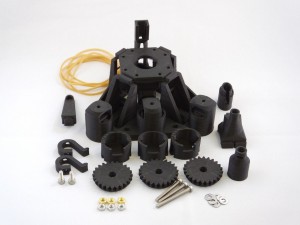 Predictions for 2017 are everywhere this time of year, and it is no wonder. There are so many technological advances, in health care and elsewhere, and a seemingly endless appetite for them. We all want the latest and greatest gadgets, we all want the most modern treatments, we all have come to increasingly rely on technology, and we all -- mostly -- see an even brighter technological future ahead. Here's my meta-prediction: some of the predicted advances won't pan out, some will delight us -- and all will end up surprising us, for better or for worse. Like Father Time and entropy, the law of unintended consequences is ultimately undefeated...
Predictions for 2017 are everywhere this time of year, and it is no wonder. There are so many technological advances, in health care and elsewhere, and a seemingly endless appetite for them. We all want the latest and greatest gadgets, we all want the most modern treatments, we all have come to increasingly rely on technology, and we all -- mostly -- see an even brighter technological future ahead. Here's my meta-prediction: some of the predicted advances won't pan out, some will delight us -- and all will end up surprising us, for better or for worse. Like Father Time and entropy, the law of unintended consequences is ultimately undefeated...
 Mission control on earth receives an urgent communication from Mars that an astronaut has fractured his shinbone. Using a handheld scanning device, the crew takes images of his damaged tibia and transmits them to earth. Orthopedic surgeons then use a 3D printer to create an exact replica of the astronaut’s leg from medical imaging files obtained before the voyage. Surgeons on earth use a robot to stabilize the bone with a metal plate on the 3D replica. The data is transmitted back to Mars, where surgical instruments, a personalized plate and screws are 3D printed. Finally, a surgical robot operates on the injured astronaut...
Mission control on earth receives an urgent communication from Mars that an astronaut has fractured his shinbone. Using a handheld scanning device, the crew takes images of his damaged tibia and transmits them to earth. Orthopedic surgeons then use a 3D printer to create an exact replica of the astronaut’s leg from medical imaging files obtained before the voyage. Surgeons on earth use a robot to stabilize the bone with a metal plate on the 3D replica. The data is transmitted back to Mars, where surgical instruments, a personalized plate and screws are 3D printed. Finally, a surgical robot operates on the injured astronaut...
 Not many teens can say they attend an Ivy League school and perhaps even fewer can claim an invention to their name. This is not the case for 17-year-old Maya Varma, an engineering student and intern at Stanford University who has developed a low-cost 3D printed device that can analyze a patient’s breath and help to diagnose pulmonary diseases. Across the globe, hundreds of millions of people suffer from respiratory conditions such as asthma, chronic obstructive pulmonary disease (COPD), chronic bronchitis, emphysema, and restrictive lung disease. In fact, respiratory diseases and infections are the third leading cause of death, after cancer and heart disease...
Not many teens can say they attend an Ivy League school and perhaps even fewer can claim an invention to their name. This is not the case for 17-year-old Maya Varma, an engineering student and intern at Stanford University who has developed a low-cost 3D printed device that can analyze a patient’s breath and help to diagnose pulmonary diseases. Across the globe, hundreds of millions of people suffer from respiratory conditions such as asthma, chronic obstructive pulmonary disease (COPD), chronic bronchitis, emphysema, and restrictive lung disease. In fact, respiratory diseases and infections are the third leading cause of death, after cancer and heart disease... Future Market Insights delivers key insights on the global 3D printed medical devices market in a new publication titled "3D Printed Medical Devices Market: Global Industry Analysis and Opportunity Assessment, 2016 - 2026". The global 3D printed medical devices market was estimated to be US$ 238 Mn in 2015 and it has a wide scope of growth in the forecast period. The global 3D printed medical devices market can be broadly classified into six segments depending on the technology namely - stereolithography (SLA), selective layer sintering (SLS), digital light processing (DLP), fused deposition modelling (FDM), polyjet / inkjet 3D printing, and electronic beam melting (EBM) - each with different applications that are specific to orthopaedic, dental, and internal and external prosthetics...
Future Market Insights delivers key insights on the global 3D printed medical devices market in a new publication titled "3D Printed Medical Devices Market: Global Industry Analysis and Opportunity Assessment, 2016 - 2026". The global 3D printed medical devices market was estimated to be US$ 238 Mn in 2015 and it has a wide scope of growth in the forecast period. The global 3D printed medical devices market can be broadly classified into six segments depending on the technology namely - stereolithography (SLA), selective layer sintering (SLS), digital light processing (DLP), fused deposition modelling (FDM), polyjet / inkjet 3D printing, and electronic beam melting (EBM) - each with different applications that are specific to orthopaedic, dental, and internal and external prosthetics... Dr Richard Bowman from the Department of Physics, working with collaborators at the University of Cambridge and Tanzanian “digital blacksmiths” STICLab, wants to create much cheaper, open-source devices such as microscopes which can be used for disease diagnosis and scientific research. The three-year project, funded through the Global Challenges Research Fund, is testing and refining a prototype general purpose optical microscope made from mass produced lenses, a Raspberry Pi mini-computer and a 3D-printed plastic frame...
Dr Richard Bowman from the Department of Physics, working with collaborators at the University of Cambridge and Tanzanian “digital blacksmiths” STICLab, wants to create much cheaper, open-source devices such as microscopes which can be used for disease diagnosis and scientific research. The three-year project, funded through the Global Challenges Research Fund, is testing and refining a prototype general purpose optical microscope made from mass produced lenses, a Raspberry Pi mini-computer and a 3D-printed plastic frame... 3D printing has received a lot of attention for its applications in the health sector, from helping Bespoke prosthetics change patients' lives to enabling huge strides in stem cell research. And with desktop 3D printers becoming increasingly affordable and reliable—and open source software such as Cura being versatile, easy to use, and free to update—barriers to further 3D printing innovation are quickly disappearing. What was once only available to well-funded practitioners has now become genuinely accessible to every patient, nurse, doctor, surgeon, hospital, and teaching facility...
3D printing has received a lot of attention for its applications in the health sector, from helping Bespoke prosthetics change patients' lives to enabling huge strides in stem cell research. And with desktop 3D printers becoming increasingly affordable and reliable—and open source software such as Cura being versatile, easy to use, and free to update—barriers to further 3D printing innovation are quickly disappearing. What was once only available to well-funded practitioners has now become genuinely accessible to every patient, nurse, doctor, surgeon, hospital, and teaching facility... As the global population continues to expand massively, with an estimated 7.5 billion people alive today, sustainability is becoming an ever-more-pressing concern. It takes a lot of energy to support a large and growing population, especially with the living standards seen in the 21st century. In the US, where capitalism looms large, affordability poses another issue as many goods and services carry with them a hefty price tag. At the convergence of a few major areas looking toward the future of sustainability is Dr. Joshua M. Pearce, who has engaged in extensive work with 3D printing, solar power, and open source research as he has headed thorough studies examining these areas and working to educate students and industry alike...
As the global population continues to expand massively, with an estimated 7.5 billion people alive today, sustainability is becoming an ever-more-pressing concern. It takes a lot of energy to support a large and growing population, especially with the living standards seen in the 21st century. In the US, where capitalism looms large, affordability poses another issue as many goods and services carry with them a hefty price tag. At the convergence of a few major areas looking toward the future of sustainability is Dr. Joshua M. Pearce, who has engaged in extensive work with 3D printing, solar power, and open source research as he has headed thorough studies examining these areas and working to educate students and industry alike...